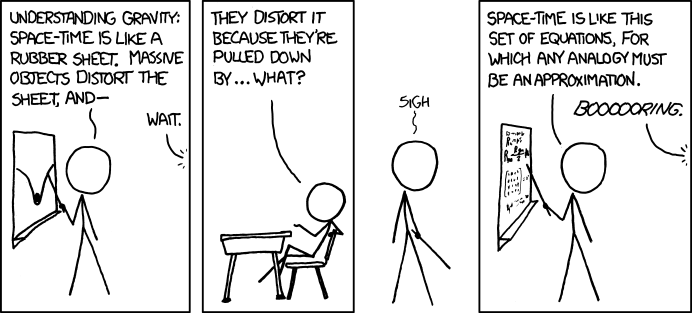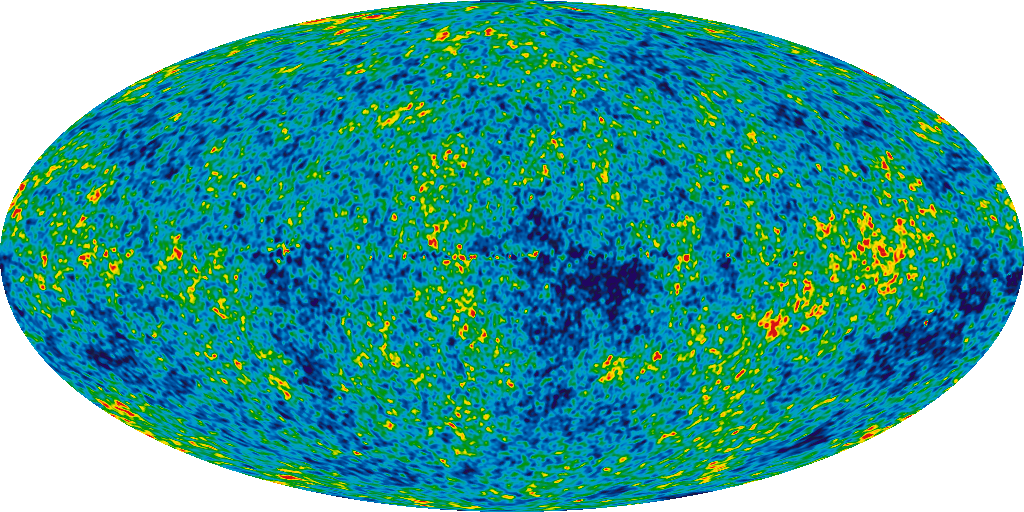[A little note: This post, like many others on this blog, contains a few mathematical symbols which are displayed using MathJax. If you are reading this using an RSS reader such as Feedly and you see a lot of $ signs floating around, you may need to click through to the blog to see the proper symbols.]
People following the reporting of physics in the popular press might remember having come across a paper earlier this year that claimed to have detected the "largest structure in the Universe" in the distribution of
quasars, that "challenged the Cosmological Principle". This was work done by Roger Clowes of the University of Central Lancashire and collaborators, and their paper was published in the
Monthly Notices of the Royal Astronomical Society back in March (though it was available online from late last year).
The reason I suspect people might have come across it is that it was accompanied by a pretty extraordinary amount of publicity, starting from
this press release on the Royal Astronomical Society website. This was then taken up by
Reuters, and featured on various popular science websites and news outlets, including
New Scientist, The Atlantic, National Geographic,
Space.com,
The Daily Galaxy,
Phys.org,
Gizmodo, and many more. The structure they claimed to have found even has its own
Wikipedia entry.
 |
| Obligatory artist's impression of a quasar. |
One thing that you notice in a lot of these reports is the statement that the discovery of this structure violates Einstein's theory of gravity, which is nonsense. This is sloppy reporting, sure, but the RAS press release is also partly to blame here, since it includes a somewhat gratuitous mention of Einstein, and this is exactly the kind of thing that non-expert journalists are likely to pick up on. Mentioning Einstein probably helps generate more traffic after all, which is why I've put him in the title as well.
But aside from the name-dropping, what about the main point about the violation of the cosmological principle? As a quick reminder, the cosmological principle is sometimes taken to be the assumption that, on large scales, the Universe is well-described as homogeneous and isotropic.
The question of what constitutes "large scales" is sometimes not very well-defined: we know that on the scale of the Solar System the matter distribution is very definitely not homogeneous, and we believe that on the scale of size of the observable Universe it is. Generally speaking, people assume that on scales larger than about $100$ Megaparsecs, homogeneity is a fair assumption. A paper by
Yadav, Bagla and Khandai from 2010 showed that if the standard $\Lambda$CDM cosmological model is correct, the scale of homogeneity
must be less than at most $370$ Mpc.
On the other hand, this quasar structure that Clowes et al. found is absolutely enormous: over 4 billion light years, or more than 1000 Mpc, long. Does the existence of such a large structure mean that the Universe is not homogeneous, the cosmological principle is not true, and the foundation on which all of modern cosmology is based is shaky?
Well actually, no.
Unfortunately Clowes' paper is wrong, on several counts. In fact, I have recently published a paper myself (journal version
here, free arXiv version
here) which points out that it is wrong. And, on the principle that if I don't talk about my own work, no one else will, I'm going to try explaining some of the ideas involved here.
The first reason it is wrong is something that a lot of people who should know better don't seem to realise: there is no reason that structures should not exist which are larger than the homogeneity scale of $\Lambda$CDM. You may think that this doesn't make sense, because homogeneity precludes the existence of structures, so no structure can be larger than the homogeneity scale. Nevertheless, it does and they can.
Let me explain a little more. The point here is that the Universe is not homogeneous, at any scale. What is homogeneous and isotropic is simply the background model we use the describe its behaviour. In the real Universe, there are always fluctuations away from homogeneity at all scales – in fact the theory of inflation basically guarantees this, since the power spectrum of potential fluctuations is close to scale-invariant. The assumption that all cosmological theory really rests on is that these fluctuations can be treated as perturbations about a homogeneous background – so that a perturbation theory approach to cosmology is valid.
Given this knowledge that the Universe is never exactly homogeneous, the question of what the "homogeneity scale" actually means, and how to define it, takes on a different light. (Before you ask, yes it is still a useful concept!) One possible way to define it is as that scale above which density fluctuations $\delta$ generally become small compared to the homogeneous background density. In technical terms, this means the scale at which the two-point correlation function for the fluctuations, $\xi(r)$, (of which the power spectrum $P(k)$ is the Fourier transform) becomes less than $1$. Based on this definition, the homogeneity scale would be around $10$ Mpc.
It turns out that this definition, and the direct measurement of $\xi(r)$ itself, is not very good for determining whether or not the Universe is a fractal, which is a question that several researchers decided was an important one to answer a few years ago. This question can instead be answered by a different analysis, which I explained once before
here: essentially, given a catalogue with the positions of many galaxies (or quasars, or whatever), draw a sphere of radius $R$ around each galaxy, and count how many other galaxies lie within this sphere, and how this number changes with $R$. The scale above which the average of this number for all galaxies starts scaling as the cube of the radius, $$N(<R)\propto R^3,$$ (within measurement error) is then the homogeneity scale (if it starts scaling as some other constant power of $R$, the Universe has a fractal nature). This is the definition of the homogeneity scale used by Yadav
et al. and it is related to an integral of $\xi(r)$; typically measurements of the homogeneity scale using this definition come up with values of around $100-150$ Mpc.
 |
| The figure that proves that the distribution of quasars is in fact homogeneous on the expected scales. For details, see arXiv:1306.1700. |
To get back to the original point, neither of these definitions of the homogeneity scale makes any claim about the existence of structures that are larger than that. In fact, in the $\Lambda$CDM model, the correlation function for matter density fluctuations is expected to be small but positive out to scales larger than either of the two homogeneity scales defined above (though not as large as Yadav et al.'s generous upper limit). The correlation function that can actually be measured using any given population of galaxies or quasars will extend out even further. So we already expect correlations to exist beyond the homogeneity scale – this means that, for some definitions of what constitutes a "structure", we expect to see large "structures" on these scales too.
The second reason that the claim by Clowes et al. is wrong is however less subtle. Given the particular definition of a "structure" they use, one would expect to find very large structures even if density correlations were exactly zero on all scales.
Yes, you read that right. It's worth going over how they define a "structure", just to make this absolutely clear. About the position of each quasar in the catalogue they draw a sphere of radius $L$. If any other quasars at all happen to lie within this sphere, they are classified as part of the same "structure", which can now be extended in other directions by repeating the procedure about each of the newly added member quasars. After repeating this procedure over all $18,722$ quasars in the catalogue, the largest such group of quasars identified becomes the "largest structure in the Universe".
It should be pretty obvious now that the radius $L$ chosen for these spheres, while chosen rather arbitrarily, is crucial to the end result. If it is too large, all quasars in the catalogue end up classified as part of the same truly ginormous "structure", but this is not very helpful. This is known as "percolation" and the critical percolation threshold has been thoroughly studied for Poisson point sets – which are by definition random distributions of points with no correlation at all. The value of $L$ that Clowes et al. chose to use, for no apparent reason other than that it gave them a dramatic result, was $100$ Mpc – far too large to be justified on any theoretical grounds, but slightly lower than the critical percolation threshold would be if the quasar distribution was similar to that of a Poisson set. On the other hand, the "largest structure in the Universe" only consists of $73$ quasars out of $18,722$, so it could be entirely explained as a result of the poor definition ...
Now I'll spare you all the details of how to test whether, using this definition of a "structure", one would expect to find "structures" extending over more than $1000$ Mpc in length or with more than $73$ members or whatever, even in a purely random distribution of points, which are by definition homogeneous. Suffice it to say that it turns out one would. This plot shows the maximum extent of such "structures" found in $10,000$ simulations of completely uncorrelated distributions of points, compared to the maximum extent of the "structure" found in the real quasar catalogue.
 |
| The probability distribution of extents of largest "structures" found in 10,000 random point sets for two different choices of $L$. Vertical lines show the actual values found for "structures" in the quasar catalogue. The actual values are not very unusual. Figure from arXiv:1306.1700. |
To summarise then: finding a "structure" larger than the homogeneity scale does not violate the cosmological principle, because of correlations; on top of that, the "largest structure in the Universe" is actually not really a "structure" in any meaningful sense. In my professional opinion, Clowes' paper and all the hype surrounding it in the press is nothing more than that – hype. Unfortunately, this is another verification of my maxim that if a paper to do with cosmology is accompanied by a big press release, it is odds-on to turn out to be wrong.
Finally, before I leave the topic, I'll make a comment about the presentation of results by Clowes
et al. Here, for instance, is an image they presented showing their "structure", which they call the 'Huge-LQG', with a second "structure" called the 'CCLQG' towards the bottom left:
Looks impressive! Until you start digging a bit deeper, anyway. Firstly, they've only shown the quasars that form part of the "structure", not all the others around it. Secondly, they've drawn enormous spheres (of radius $33$ Mpc) at the position of each quasar to make it look more dramatic. In actual fact the quasars are way smaller than that. The combined effect of these two presentational choices is to make the 'Huge-LQG' look far more plausible as a structure than it really is. Here's a representation of the exact same region of space that I made myself, which rectifies both problems:
 |
| Quasar positions around the "structures" claimed by Clowes et al. |
Do you still see the "structures"?
















